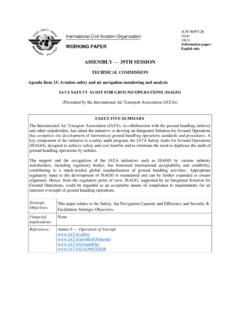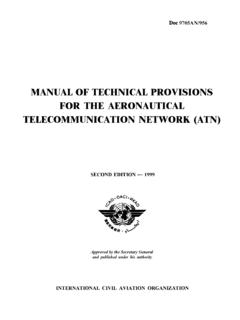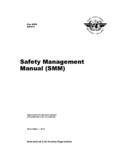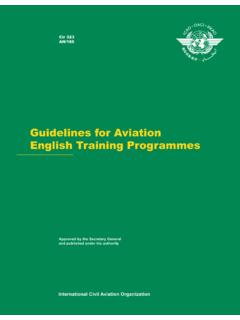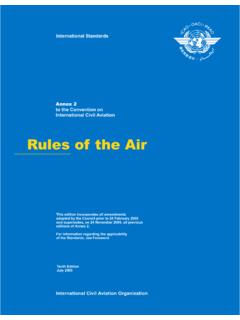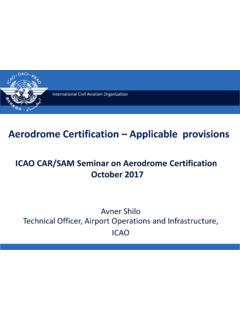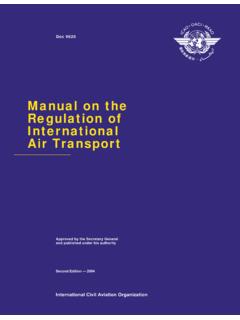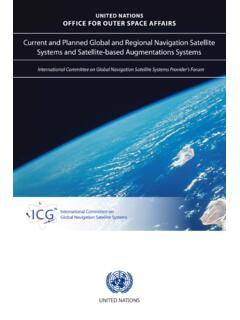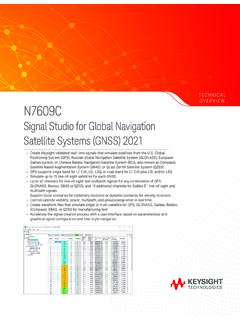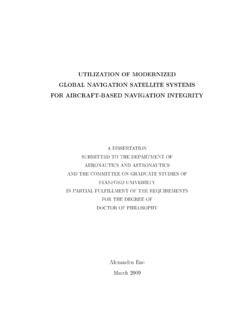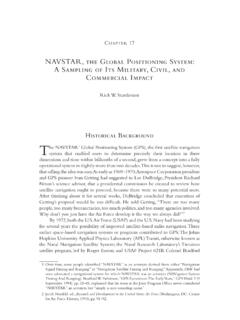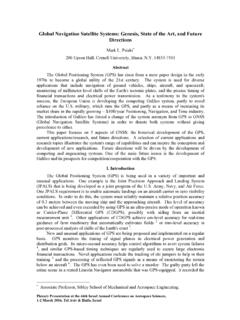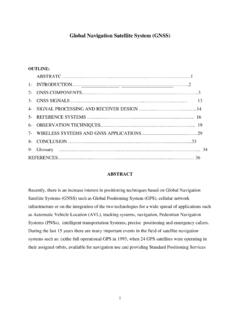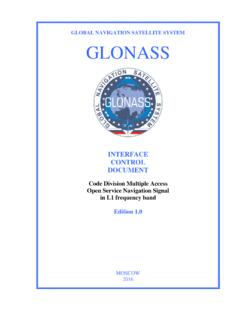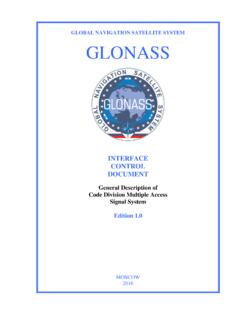Transcription of Global Navigation Satellite System (GNSS) Manual
1 Global Navigation Satellite System (GNSS) Manual _____ Second Edition June 2012 Notice to Users This document is an unedited advance version of an ICAO publication as approved, in principle, by the Secretary General, which is rendered available to the public for convenience. The final edited version may still undergo alterations in the process of editing. Consequently, ICAO accepts no responsibility or liability of any kind should the final text of this publication be at variance from that appearing here. Advanced edition (unedited) Doc 9849 AN/457 EXECUTIVE SUMMARY The growth of aviation and the urgent need to reduce fuel consumption, emissions and delays demands increased airspace and airport capacity as well as a focus on providing a preferred trajectory (route and altitude) to each airspace user.
2 This, in turn, dictates improvements to communications, Navigation and surveillance (CNS) services. Aircraft operators also require efficiency gains via approaches that offer the lowest possible minima and the significant safety benefits of straight-in approaches and vertical guidance. The draft fourth edition of the Global Air Navigation Plan (Doc 9750, GANP) presents a high level summary of ICAO s Aviation System Block Upgrade (ASBU) methodology. The ASBUs define operational objectives that address four specific and interrelated aviation performance areas: greener airports; globally interoperable systems and data; optimum capacity; and flexible flights and efficient flight paths.
3 The draft GANP and ASBUs recognize the Global Navigation Satellite System (GNSS) as a technical enabler supporting improved services that meet these objectives. Roadmaps in the draft GANP outline timeframes for the availability of GNSS elements, the implementation of related services and the rationalization of conventional infrastructure. GNSS supports positioning, Navigation and timing (PNT) applications. GNSS is already the foundation of Performance-Based Navigation (PBN), Automatic Dependent Surveillance Broadcast (ADS-B) and Automatic Dependent Surveillance Contract (ADS-C), described below. GNSS also provides a common time reference used to synchronize systems, avionics, communication networks and operations, and supports a wide range of non-aviation applications.
4 The ICAO Charter on the Rights and Obligations of States Relating to GNSS Services highlights the principles that shall apply in the implementation and operation of GNSS, including: the primacy of safety; non-discriminatory access to GNSS services; State sovereignty; the obligation of provider States to ensure reliability of services; and cooperation and mutual assistance in Global planning. The goal of this Manual is to provide information about GNSS technology and operational applications to assist State regulators and air Navigation service (ANS) providers to complete the safety and business case analyses needed to support implementation decisions and planning. GNSS Implementation The introduction of GNSS-based services was made possible by the operational implementation of two core Satellite constellations, the Global Positioning System (GPS) and the Global Navigation Satellite System , (GLONASS) provided, respectively, by the United States of America and the Russian Federation.
5 GPS and GLONASS signals are defined in Annex 10 Standards and Recommended Practices (SARPs). In 1994, the United States offered GPS to support the needs of international civil aviation, and reaffirmed the offer in 2007; the ICAO Council accepted both offers. In 1996, the Russian Federation offered GLONASS to support the needs of international civil aviation; the ICAO Council accepted this offer. Both States are upgrading their constellations and have committed to ICAO to take all necessary measures to maintain service reliability. Europe and China are developing systems (Galileo and Beidou) that will be interoperable with upgraded GPS and GLONASS. The availability of multiple constellations addresses certain technical and institutional issues.
6 GPS was declared fully operational in 1993, and several States approved the use of GPS guidance for Instrument Flight Rules (IFR) en route, terminal and non-precision approach (NPA) operations that same year. In 2001 ICAO adopted SARPs supporting GNSS operations based on augmenting core Satellite constellation signals to meet safety and reliability requirements. 2 There are three augmentation systems defined in Annex 10: the Aircraft-Based Augmentation System (ABAS); the Satellite -Based Augmentation System (SBAS); and the Ground-Based Augmentation System (GBAS). ABAS is an avionics implementation that processes GPS and/or GLONASS signals to deliver the accuracy and integrity required to support en route, terminal and non-precision approach (NPA) operations.
7 SBAS uses a network of ground reference stations and provides signals from Geostationary Earth Orbit (GEO) satellites to support operations from en route through to approaches with vertical guidance over a large geographic area. SBAS approach operations do not require augmentation stations at the airports served. The Wide Area Augmentation System (WAAS), an SBAS developed by the United States, has been operational since 2003. It also provides service in Canada and Mexico. The Japanese Multi-functional Transport Satellite (MTSAT) Satellite -based Augmentation System (MSAS) became operational in 2007. The European Geostationary Navigation Overlay Service (EGNOS) became operational in early 2011.
8 The Indian GPS and GEO Augmented Navigation System (GAGAN) is expected to be operational in 2013. The Russian System for Differential Correction and Monitoring (SDCM) is under development and is expected to be operational in 2015. These systems have the potential to support seamless guidance where their service areas overlap. As of 2012, almost 3,000 SBAS vertically guided approach procedures were implemented, mostly in North America, some of which support Category I (CAT I) minima, currently provided by the instrument landing System (ILS). Over 1,100 of these serve airports without ILS. For technical reasons described in this Manual , the current SBAS architecture cannot reliably support approaches with vertical guidance in equatorial areas.
9 GBAS uses monitoring stations at airports to process signals from core constellations and broadcast corrections and approach path data to support precision approach operations. As of 2012, approximately 40 GBAS stations around the world were supporting testing and CAT I operations with special approvals. GBAS has the potential to support CAT II/III and some surface movement operations, as well as terminal area Navigation . Performance-Based Navigation (PBN) One key to increased airspace capacity is a transition to a total area Navigation environment in which aircraft maintain flight paths within defined corridors. GNSS-based PBN provides a seamless, harmonized and cost-effective guidance from departure to vertically guided final approach that provides safety, efficiency and capacity benefits.
10 The PBN Manual (Doc 9613) describes implementation processes, and for each Navigation application, ANS provider considerations and a Navigation specification describing performance, functionality and associated operations. Navigation specifications include approval processes and requirements for aircraft, aircrew knowledge and training. The PBN concept represents a shift from technology-based to performance-based Navigation , but for all except the least demanding applications, GNSS is required. GNSS enables States to develop a PBN implementation plan in accordance with ICAO Resolution A37/11. Automatic Dependent Surveillance Broadcast (ADS-B) Improved surveillance performance is the key to reduced separation standards, increased airspace capacity and the ability to support user-preferred trajectories.
